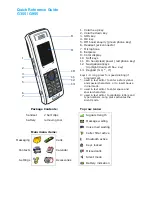
165
Use only approved batteries and recharge your battery only with approved chargers. When a charger is not
in use, disconnect it from the power source. Do not leave the battery connected to a charger for more than
a week, since overcharging may shorten its life.
Extreme temperatures will affect the charging capacity of your battery: it may require cooling or warming
first.
Do not leave the battery in hot or cold places, such as in a car in summer or winter conditions, as you will
reduce the capacity and life-time of the battery. Always try to keep the battery at room temperature. A
phone with a hot or cold battery may temporarily not work, even when the battery is fully charged. Li-ion
batteries are particularly affected by temperatures below 0 C (32 F).
Accidental short circuiting can occur when a metallic object (coin, clip or pen)causes a direct connection
between the + and - terminals of the battery (metal strips on the back of the battery), for example when
you carry a spare battery in a pocket or bag. Short-circuiting the terminals may damage the battery or the
object causing the short-circuit.
Dispose of used batteries in accordance with local regulations. Always recycle. Do not dispose of batteries in
a fire.
164
OTHER FUNCTIONS
Safety Information
Traffic Safety
Do not use a hand-held mobile phone while driving a vehicle. If using a hand-held phone, park the vehicle
before conversing. Always secure the phone in its holder, do not place the phone on the passenger seat or
where it can break loose in a collision or sudden stop.
The use of an alert device to operate a vehicle lights or horn on public roads is not permitted.
Remember, road safety always comes first!
Operating Environment
Remember to follow any special regulations in force in any area and always switch off your phone whenever
it is forbidden to use it, or when it may cause interference of danger.
When connecting the phone or any accessory to another device, read its users guide for detailed safety
instructions. Do not connect incompatible products.
As with other mobile radio transmitting equipment, users are advised that for the satisfactory operation of
the equipment and for the safety of personnel, it is recommended that the equipment should only be used in
the normal operating position (held to your ear with the antenna pointing over your shoulder).













































